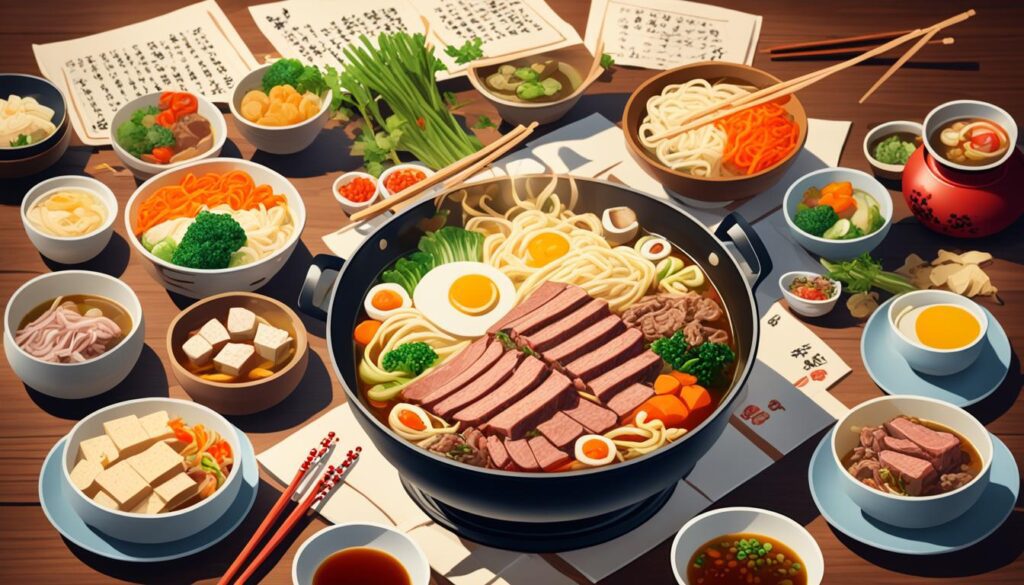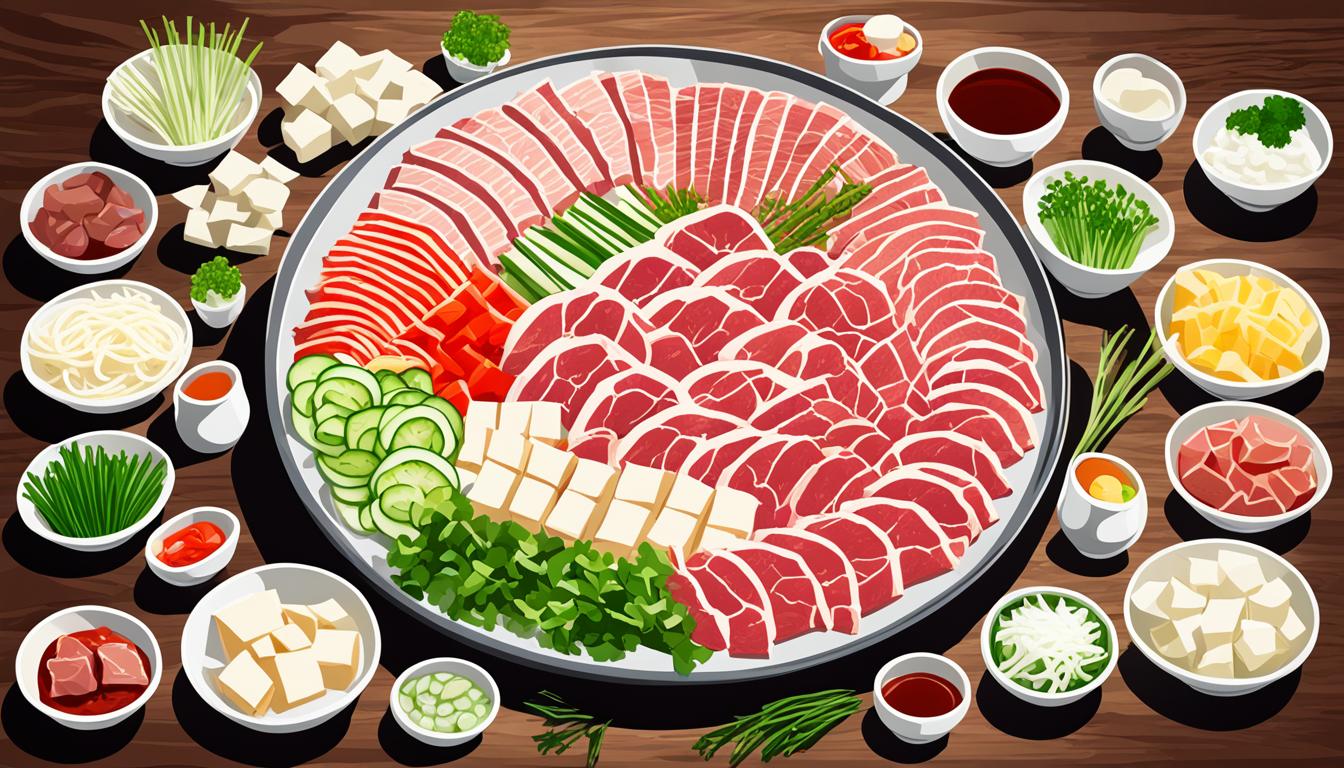Welcome to our Japanese culinary journey, where we explore the rich and flavorful world of traditional Japanese dishes. In this article, we will delve into the meaning and cultural significance of sukiyaki, a beloved Japanese hot pot dish. Discover the origins, preparation techniques, and the ingredients that make sukiyaki a delightful culinary experience. Let’s dive right in!
Ingredients in Sukiyaki
Sukiyaki is a delicious Japanese dish that brings together a variety of flavorful ingredients. The key component of sukiyaki is thinly sliced beef, which adds a rich and savory taste to the dish. In the past, pork was also used as an alternative in certain regions. Along with the beef, sukiyaki traditionally includes an assortment of vegetables, tofu, and other complementary ingredients.
Here are some commonly used sukiyaki ingredients:
| Sukiyaki Ingredient | Description |
|---|---|
| Sukiyaki Beef | Thinly sliced beef that cooks quickly and absorbs the flavorful broth. |
| Sukiyaki Vegetables | Leafy vegetables like Chinese cabbage and shungiku, which add freshness and texture. |
| Sukiyaki Tofu | Firm tofu that soaks up the delicious broth and provides a nice contrast to the beef. |
| Negi (Scallion) | A type of scallion that adds a mild onion flavor to the sukiyaki. |
| Mushrooms | Commonly used mushrooms in sukiyaki include shiitake and enokitake, which impart an earthy taste. |
| Glass Noodles | Thin translucent noodles made from konnyaku or corm that absorb the flavors of the broth. |
| Boiled Wheat Udon or Mochi Rice Cakes | Added towards the end of cooking to soak up the broth and create a delightful chewy texture. |
These ingredients come together to create a comforting and satisfying meal. The combination of the succulent beef, fresh vegetables, and the umami-rich broth make sukiyaki a beloved dish in Japanese cuisine.
Preparation of Sukiyaki
To create a delicious sukiyaki dish, there are two main cooking styles you can choose from: Kanto style and Kansai style. Each style has its own unique approach but results in a delightful dining experience.
Kanto-style Sukiyaki
In Kanto-style sukiyaki, the cooking process starts with preparing a flavorful mixture called warishita. This mixture consists of sake, soy sauce, sugar, mirin, and dashi, which is a Japanese cooking stock. Here’s a step-by-step guide on how to prepare Kanto-style sukiyaki:
- Pour the warishita into the sukiyaki pot.
- Heat the pot until the warishita starts to simmer.
- Add thinly sliced beef and cook until it changes color.
- Add various vegetables, such as tofu, negi, Chinese cabbage, and mushrooms.
- Allow the ingredients to cook together, absorbing the rich flavors of the warishita.
- Serve the sukiyaki with a bowl of steamed rice or noodles.
Kanto-style sukiyaki tends to use a larger amount of warishita, resulting in a sweeter and more savory taste compared to its Kansai counterpart.
Kansai-style Sukiyaki
Kansai-style sukiyaki takes a slightly different approach to cooking this Japanese hot pot dish. In Kansai style, the meat is heated first before adding sugar, sake, and soy sauce. The vegetables and other ingredients are then added towards the end of the cooking process. Here’s how to prepare Kansai-style sukiyaki:
- Start by heating the pot.
- Add the thinly sliced beef and cook until it changes color.
- Next, add sugar, sake, and soy sauce to enhance the flavors of the meat.
- Once the sauce has infused into the beef, add the vegetables and other desired ingredients.
- Cook everything together until the vegetables are tender.
- Serve the sukiyaki with a bowl of steamed rice or udon noodles.
Kansai-style sukiyaki places more emphasis on the natural flavors of the ingredients, resulting in a lighter and more delicate taste.
| Kanto-style Sukiyaki | Kansai-style Sukiyaki |
|---|---|
| Uses warishita, a flavorful mixture of sake, soy sauce, sugar, mirin, and dashi. | Meat is heated first, followed by the addition of sugar, sake, and soy sauce. |
| Vegetables are added after the meat has cooked. | Vegetables are added towards the end of the cooking process. |
| Results in a sweeter and more savory taste. | Emphasizes the natural flavors of the ingredients for a lighter taste. |
History and Origins of Sukiyaki

The history of sukiyaki is closely tied to the introduction of Buddhism to Japan, which prohibited the consumption of meat. However, there were exceptions for special circumstances and events, such as year-end parties where sukiyaki became a popular dish. The word “sukiyaki” has various possible origins, including referencing the use of spades for cooking or thinly sliced meat. The dish gained more popularity during the Meiji era (1868-1912) with the introduction of meat-eating customs from other countries.
Sukiyaki has deep roots in Japanese culture and traditions. Its origins can be traced back to the introduction of Buddhism to Japan, which forbade the consumption of meat. However, there were exceptions for certain occasions, including special events and year-end parties. It was during these gatherings that sukiyaki emerged as a popular and beloved dish.
The exact origin of the word “sukiyaki” is uncertain, but it is believed to refer to the use of spades for cooking or the thinly sliced meat that is the star of the dish. Regardless of its etymology, sukiyaki gained widespread popularity during the Meiji era, a time when Japan began adopting meat-eating customs from other countries.
Other Varieties of Hot Pot Dishes
Sukiyaki is just one type of hot pot dish in Japanese cuisine. There are several other delicious variations that you should definitely try!
Shabu-Shabu
Shabu-shabu is a popular hot pot dish where thinly sliced meat and vegetables are cooked by dipping them in a boiling dashi stock at the table. The name “shabu-shabu” actually comes from the swishing sound that the ingredients make when they are cooked in the hot broth. This interactive and flavorful dish is perfect for sharing with friends and family.
Oden
Oden is a comforting hot pot dish that features a variety of ingredients, including fish cakes, konnyaku (a type of gelatinous root vegetable), daikon radish, and boiled eggs. These ingredients are simmered in a seasoned dashi stock until they become tender and flavorful. Oden is a popular dish during the winter months in Japan and is often enjoyed as a snack or a light meal.
Chanko-Nabe
Chanko-nabe is a hot pot dish that is closely associated with sumo wrestlers in Japan. It is a hearty and nourishing dish that helps sumo wrestlers gain weight and build muscle. Chanko-nabe typically includes a variety of ingredients such as chicken, fish, tofu, vegetables, and noodles cooked in a rich, flavorful broth. This dish is not only delicious but also provides the necessary energy and nutrients for sumo wrestlers to maintain their strength and stamina.
Yudofu
Yudofu is a simple and delicate hot pot dish that focuses on tofu as the main ingredient. The tofu is gently simmered in a kombu (kelp) and dashi broth until it becomes soft and silky. Yudofu is often enjoyed with a dipping sauce made from soy sauce and grated ginger. This dish highlights the natural flavors of tofu and is perfect for those looking for a lighter hot pot option.
Kani-Nabe
Kani-nabe is a hot pot dish that highlights the delicious flavors of crab. Fresh crab, along with vegetables like mushrooms and cabbage, is simmered in a flavorful broth until it becomes tender and infused with the essence of crab. This dish is a luxurious treat for seafood lovers and is especially popular during the winter months when crab is in season.
Chige-Nabe
Chige-nabe is a spicy hot pot dish that is influenced by Korean cuisine. It typically includes ingredients like kimchi, pork, tofu, and vegetables, cooked in a spicy broth made from gochujang (Korean chili paste). Chige-nabe is known for its bold and fiery flavors, making it a favorite among those who enjoy spicy dishes.
| Hot Pot Dish | Main Ingredients | Description |
|---|---|---|
| Shabu-Shabu | Thinly sliced meat, vegetables | Ingredients are dipped in boiling dashi stock at the table |
| Oden | Fish cakes, konnyaku, daikon radish, boiled eggs | Simmered in seasoned dashi stock for a comforting taste |
| Chanko-Nabe | Chicken, fish, tofu, vegetables, noodles | Hearty and nourishing hot pot associated with sumo wrestlers |
| Yudofu | Tofu | Gently simmered tofu in a kombu and dashi broth for a delicate flavor |
| Kani-Nabe | Crab, mushrooms, cabbage | Luxurious hot pot dish that highlights the flavors of crab |
| Chige-Nabe | Kimchi, pork, tofu, vegetables | Spicy hot pot dish influenced by Korean cuisine |
Related Japanese Culinary Terms
Japanese cuisine is renowned for its diverse range of culinary terms and dishes that have captivated the taste buds of food enthusiasts around the world. Let’s explore some of the most popular Japanese culinary terms:
Sushi: A delicacy that combines vinegared rice with a selection of raw fish, shellfish, or vegetables. Sushi is often served with soy sauce, pickled ginger, and wasabi.
Tempura: Crispy and light, tempura refers to deep-fried battered fish, shellfish, or vegetables. The ingredients are coated in a special tempura batter and then fried until golden and delicious.
Ramen: Originally stemming from Chinese cuisine, ramen has become a staple in Japanese culinary culture. It features Chinese-style wheat noodles served in a flavorful broth, topped with various ingredients such as sliced pork, green onions, and bamboo shoots.
Miso Soup: A beloved Japanese soup made with a savory broth derived from fermented soybean paste called miso. It typically contains ingredients like tofu, seaweed, and sliced green onions, making for a comforting and nourishing dish.
Sashimi: A pure and elegant delicacy, sashimi consists of thinly sliced, fresh raw fish or seafood. It is often served as an appetizer or part of a larger traditional Japanese meal.
These culinary terms are just a glimpse into the rich tapestry of Japanese cuisine. Savoring these dishes allows you to experience the intricacies and the depth of flavors that have made Japanese cuisine a favorite worldwide.
So whether you indulge in the exquisite melt-in-your-mouth sashimi, delight in the crispness of tempura, slurp up a steaming bowl of ramen, or savor the umami goodness of miso soup, Japanese culinary traditions offer something for everyone.

